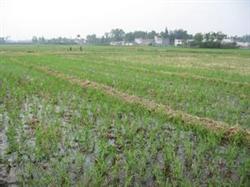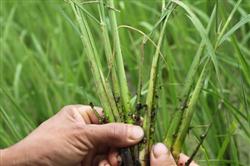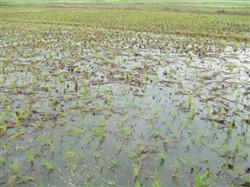Key points of no-tillage rice seedling throwing operation

Rice no-tillage seedling throwing refers to the rice field without any ploughing and harrowing after harvesting the previous crop, first use herbicides to kill weed plants and irrigated rice seedlings, destroy withered rice piles, irrigate and fertilize the field, and wait for the water layer to dry or drain shallow water. a new rice cultivation technique of throwing plastic tray seedlings or paper tube seedlings into the field. The key techniques of late cultivation and no-tillage seedling throwing are introduced as follows: 1. No-tillage rice seedling throwing should be carried out in rice fields with sufficient water source, convenient drainage and irrigation, smooth surface, deep plough layer and good ability of water and fertilizer conservation. Dry fields and shallow, thin, leaking sandy shallow fields are not suitable for no-tillage fields. Low-lying fields, mountain pits, cold-soaked fields, rotten fields (common to the bottom of the day plus three points of water), etc., should open ring ditches and cross ditches before no-tillage chemical weeding, and drain the field water in time. 2. The treatment methods of rice stakes and weeds are made late, because there are many Rain Water, and the main objects of chemical stubble are rice stakes and fallen grain seedlings, so the biocidal herbicides used in no-tillage should have the characteristics of high speed, high efficiency and strong rain tolerance. After years of experimental screening and production application, it is shown that Kewuzhuan is an ideal herbicide for chemical stubble control under no-tillage, and its application effect is very good in both early and late production, especially in late production. The specific operations are as follows: during the early rice harvest, the grain head should be cut as low as possible, and the height of the rice pile should not exceed 15 cm. After moving away from the rice stalk, wet fields should be irrigated to promote the sprouting and emergence of fallen grain. 10 days before throwing seedlings, drain the field water, add 2.5 kg ammonium bicarbonate or potassium chloride with 2.5 kg ammonium bicarbonate or potassium chloride per mu, and spray evenly on rice stump, fallen grain seedlings and weed stems and leaves with sprayer. The next day after spraying, make up spraying on the place where the spray is missing. The field was soaked in deep water on the second day of supplementary spraying, and the best water depth was submerged rice pile. The application of calcium superphosphate, ammonium bicarbonate or compound fertilizer as base fertilizer could accelerate the decay of rice pile and weeds. Soak the paddy field for 7 days until the water layer dries naturally or drains shallow water before throwing seedlings. Pre-budding weeds can be treated with soil before throwing seedlings or killed after throwing seedlings, and the types and application methods of herbicides are the same as those in conventional tillage seedling throwing fields. 3. Technical points of high-yield cultivation and management of no-tillage rice seedling throwing seedlings should be raised by using a large pore diameter plate (350 / 400 holes / piece) or a special paper tube for no-tillage seedling cultivation, and the suitable leaf age for no-tillage seedling throwing is 2.5ml / 3.5. The planting density in the field is about 10% higher than that of throwing seedlings under normal tillage. The total amount of fertilization is about 10% higher than that of conventional tillage and throwing seedlings. Light application of basic fertilizer and heavy application of green fertilizer and tillering fertilizer should reach more than 60% of the total amount of fertilizer in the early stage. The base fertilizer is mainly compound fertilizer and phosphate fertilizer, less ammonium bicarbonate is applied, and the base fertilizer can not be applied with immature organic fertilizer to avoid burning seedlings. In water management, it requires frequent shallow irrigation, more sun and light sun. The practice of throwing seedlings in shallow water, thin water to promote seedlings and tillering, avoid deep water in the early stage of tillering, dry and dry the field in the early tillering stage, keep moist after the young panicle differentiation stage, have shallow water layer in the heading and flowering stage, dry and wet in the grain filling stage to prevent premature water loss. The control of diseases and insect pests is more or less the same as that of throwing seedlings under normal tillage, and do a good job in the control of rice blast, sheath blight, bacterial leaf blight, Fushu snail, Chilo suppressalis, rice leaf roller, rice planthopper, etc., especially to strengthen the monitoring and control of rice stem borer and rice stem borer.
- Prev

Opinions on the Control of Disease and Cordyceps in Rice Field
Rice black-streaked dwarf disease in southern China is a viral disease mainly transmitted by white-backed planthopper, which mainly harms major food crops such as rice and corn. Once the crops are susceptible, the plants are dwarfed, the tillers increase, and the diseased rice can not heading and fruiting in the later stage of growth, even no grain harvest. It is a serious threat to the safety of grain production in our county. For science.
- Next

Cultivation techniques of No-tillage and dry Direct seeding of Rice
(1) Paddy fields that were previously used as rice without ploughing were selected for no-tillage, dry and direct seeding cultivation. Fields with many malignant weeds and heavy stickiness are not suitable for no-tillage cultivation. (2) 4-6 days before weed treatment and sowing, choose sunny or cloudy days with temperatures above 15 degrees and use 10% glyphosate 2 kg per mu.
Related
- The first cup of black tea in spring, the flavor and history of tea gardens in Kenya, Africa
- The computer can not only choose potatoes, but also grow tea rice. AI will grow winter oolong tea champion.
- It is not only the inflated tea bitten by insects, but also engraved with the four seasons tea in Beipu.
- The Oriental Beauty Tea Festival in Zhuxian County takes the stage at the weekend to experience the plus-size feast of oil tea.
- & quot; Oriental Beauty Tea & Exploration of Emei in Hsinchu, the hometown of quot;
- The new variety of strawberry "Tainong 1" dessert is the first choice with mellow aroma. Crimson gorgeous
- History of Tea in Taiwan: from Wild Inner Mountain to Export Tea Garden
- Two types of Taiwan Oriental Beauty Black Tea won the British three-Star Award for Childhood Tea Xiang Zhang Jiaqi changed from pilot to champion tea maker.
- Banana species and varieties: the planting history of Taiwan Xianren banana and dwarf banana is long, is banana disease resistant?
- Coffee planting Technology: Qianjie Coffee from Seedling to harvesting

